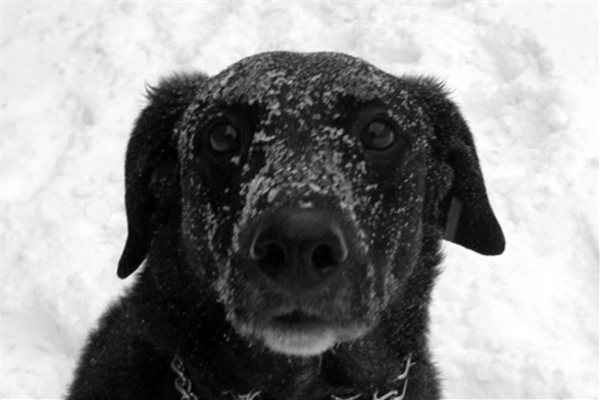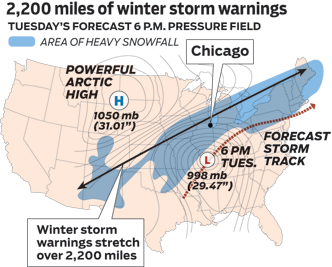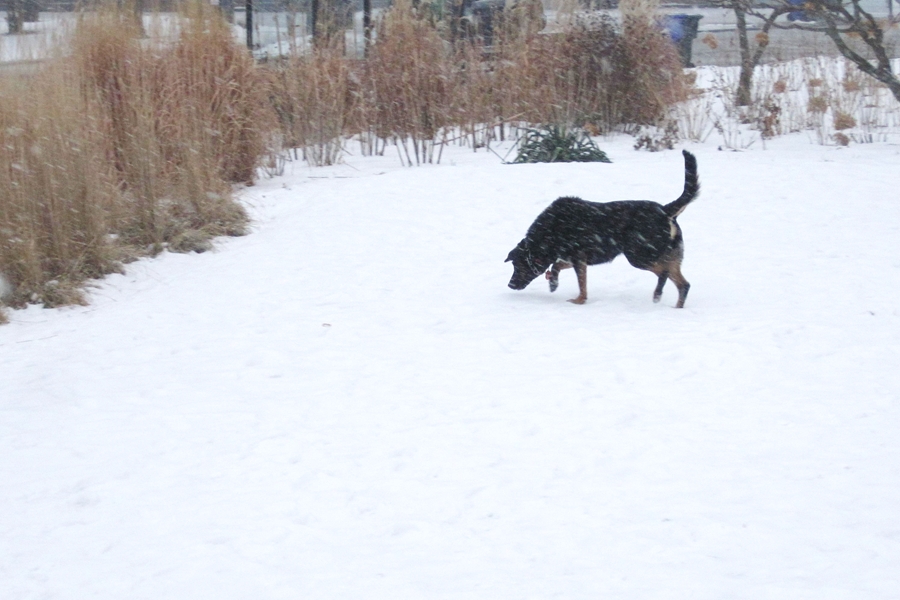
Chicago weather conditions at 4pm: -6°C, winds northeast at 48 km/h gusting to 63 km/h, visibility 400 m in heavy, blowing snow.
Here's the corner of Belden and Clark in Lincoln Park around then:
And a little north of that, looking north:
The ParkerCam will be pointing out the window at Inner Drive Technology World Headquarters today, in case anyone wants to watch the blizzard in progress for the duration of the event:

 The weather we've worried about for a couple of days looks set to hit this afternoon:
The weather we've worried about for a couple of days looks set to hit this afternoon:
Four days of computer forecasts of this storm, including multiple runs off 7 models, are putting the developing system on a more northerly track while generating water equivalent precipitation of around 30 mm. To convert that to snow, calculations have to be made of how snowflakes are likely to develop in the storm given a snow/water ratio predicted to be 15 to 1 Tuesday evening. [This means 450 mm of snow. —ed.]
As expected, Lake Michigan may contribute an additional 75 to 175 mm to the system in lakeside counties
The National Weather Service warns:
A BLIZZARD WARNING REMAINS IN EFFECT FROM 3 PM THIS AFTERNOON TO
3 PM CST WEDNESDAY.
* TIMING...ACCUMULATING SNOW WILL DEVELOP AROUND THE INTERSTATE 80
CORRIDOR DURING THE EARLY TO MID AFTERNOON...SPREADING NORTH TO
THE WISCONSIN STATE LINE BY MID TO LATE AFTERNOON. THE MOST
SIGNIFICANT SNOW MAY COME IN A COUPLE OF WAVES...WITH THE FIRST
WAVE LATE THIS AFTERNOON INTO EARLY THIS EVENING...FOLLOWED BY A
SECOND WAVE OF INTENSE SNOW LATER THIS EVENING INTO THE
OVERNIGHT. ACCUMULATING LAKE EFFECT SNOW SHOWERS WILL CONTINUE
OVER NORTHEAST ILLINOIS WEDNESDAY MORNING...SPREADING INTO
NORTHWEST INDIANA WEDNESDAY AFTERNOON.
* ACCUMULATIONS...SNOW WILL BE HEAVY AT TIMES WITH ACCUMULATION
RATES OF 1 TO 2 INCHES PER HOUR LIKELY. STORM TOTAL SNOWFALL OF
10 TO 18 INCHES IS LIKELY TOWARD ROCKFORD AND DIXON. THE
HEAVIEST SNOWFALL TOTALS ARE LIKELY DOWNWIND OF LAKE MICHIGAN IN
THE CHICAGO METROPOLITAN AREA INTO NORTHWEST INDIANA WHERE 12 TO
20 INCHES OF SNOW IS LIKELY...WITH ISOLATED AMOUNTS OF AROUND 2
FEET POSSIBLE.
* WINDS...NORTHEAST WINDS WILL INCREASE TO 20 TO 35 MPH BY LATE
THIS AFTERNOON. WIND GUSTS UP TO 40 MPH WILL BE POSSIBLE BY
EVENING WITH GUSTS OF 40 TO 50 MPH LIKELY TONIGHT. EVEN STRONGER
WINDS ARE LIKELY NEAR THE IMMEDIATE LAKESHORE WITH SUSTAINED
WINDS OF 30 TO 40 MPH WITH GUSTS BETWEEN 50 AND 60 MPH.
The Daily Parker will have updates and photos as conditions warrant.
We're likely to begin February with the biggest snowfall in Chicago's recorded history:
A Blizzard Watch is in effect Tuesday afternoon through Wednesday as a strengthening low pressure system moves up the Ohio Valley. Late Tuesday afternoon steady snow and stronger winds will push into the region, starting south of I-80 and spreading north during the evening.
Snowfall rates Tuesday night could approach 50 to 80 mm per hour and when combined with sustained winds at 50-60 km/h, visibilities are will drop significantly with near whiteout conditions possible.
Snow totals of 30 to 50 cm are possible between Monday night and Wednesday afternoon with locally higher amounts. Drifting and blowing snow will make travel dangerous and possibly life threatening Tuesday night.
Lakeshore flooding is also a possibility. Waves of 3 to 5 m will crash along the Illinois side of the Lake Michigan shoreline.
Oh. Joy.
Every year, I surprise myself by the amount of money I loan the United States, interest-free. Today I found out it's about double what I estimated earlier. This isn't a good thing: while I have no objection to paying taxes, I object strongly to over-paying during the tax year, even if they do refund it a week after I ask for it.
</ rant>
This winter Chicago has had below-average temperatures overall but nothing really cold. It's like a study in moderation, only unusual when you see the numbers rather than when you experience it:
Just one day this season has produced a sub-minus-17 Celsius low temperature and only one day has failed to climb out of single digits. Since the start of the three month (December through February) meteorological winter period, 38 of the 59 days—64% of them—have generated below normal readings.
It's a fact that except for New Year's Day, not a single day has produced a high over 4°C. And, the month of January has hosted only three days with highs above freezing—a fraction of the 141-year average of 14 above-freezing days to date. That's the fewest above-freezing days to occur in a January here in the 34 years since 1977.
Temperatures Saturday may poke above freezing long enough to turn the snow which has covered the ground here for 19 consecutive days a bit slushy. But a thaw capable of melting snow currently on the ground isn't in sight as we approach February 2011's arrival Tuesday, nor is a thaw expected in the week which follows.
The official temperature right now is 1°C, the warmest we expect it to be for at least the next week.
New York City has had its 6th and 8th biggest snowstorms of all time this winter, and it's a week away from another one:
Here is the complete list of the top-ten biggest snows there from Dr. Jeff Masters' Wunderblog:
1) 26.9" Feb 11-12, 2006
2) 26.4" Dec 26-27, 1947
3) 21.0" Mar 12-14, 1888
4) 20.8" Feb 25-26, 2010
5) 20.2" Jan 7-8, 1996
6) 20.0" Dec 26-27, 2010
7) 19.8" Feb 16-17, 2003
8) 19.0" Jan 26-27, 2011
9) 18.1" Mar 7-8, 1941
10) 17.7" Feb 5-7, 1978
I remember the one in February 2003: it stranded me in Washington for two days. At the Hyatt. Which, you know, really wasn't horrible, all things considering.
I digress.
The Canadian weather bureau forecasts another winter storm to dip around the Great Lakes and hit Chicago on Tuesday; however, all the other models in the world project the storm slinking much farther East and hitting Atlanta, Raleigh, DC, New York, and Boston.
By the way, one of the major predictions of anthropomorphic climate change theory is that the North American storm track will shift south. It used to go pretty much straight across Illinois during the winter and across Wisconsin in the summer. Now we're seeing the track generally around Nashville in the winter and St. Louis in the summer. That means, a warmer climate overall will cause more precipitation in the Southeast and Northeast during the winter, and more in the Central Plains during the summer. It also means generally milder weather around the Great Lakes.
Via Conor Friedersdorf, New York Times Executive Editor Bill Keller has a detailed essay about how and why the Times published the last Wikileaks dump. He concludes
Although it is our aim to be impartial in our presentation of the news, our attitude toward these issues is far from indifferent. The journalists at The Times have a large and personal stake in the country’s security. We live and work in a city that has been tragically marked as a favorite terrorist target, and in the wake of 9/11 our journalists plunged into the ruins to tell the story of what happened here. Moreover, The Times has nine staff correspondents assigned to the two wars still being waged in the wake of that attack, plus a rotating cast of photographers, visiting writers and scores of local stringers and support staff. They work in this high-risk environment because, while there are many places you can go for opinions about the war, there are few places — and fewer by the day — where you can go to find honest, on-the-scene reporting about what is happening. We take extraordinary precautions to keep them safe, but we have had two of our Iraqi journalists murdered for doing their jobs. We have had four journalists held hostage by the Taliban — two of them for seven months. We had one Afghan journalist killed in a rescue attempt. Last October, while I was in Kabul, we got word that a photographer embedded for us with troops near Kandahar stepped on an improvised mine and lost both his legs.
We are invested in the struggle against murderous extremism in another sense. The virulent hatred espoused by terrorists, judging by their literature, is directed not just against our people and our buildings but also at our values and at our faith in the self-government of an informed electorate. If the freedom of the press makes some Americans uneasy, it is anathema to the ideologists of terror.
I'm with Friedersdorf; I think this gets it right. He says:
This description – and it seems fair and accurate to me – puts the Times in a much different light than is cast by some of its critics, who'd have us believe that the newspaper, which in many ways is establishmentarian (to a fault on occassion), is actually a trangressive, post-national entity with a knee-jerk tenency to blame America first.
I submit that in the matter of Wikileaks, the American people were a lot better off for the involvement of The New York Times than we would've been had the documents been dumped on the Internet without the newspaper's involvement – and that, even if you disagree with some of the decisons they made, which is reasonable enough, their approach to this matter was cogent and defensible.
Both the article and Friedersdorf's analysis are worth reading.
Finally, this ridiculous exercise has ended. The Illinois Supreme Court ruled unanimously just a few minutes ago that Rahm Emanuel is a resident of Chicago, and therefore can stay on the ballot for city mayor:
The Chicago election board and a Cook County Circuit judge both ruled Emanuel met the residency requirements. The Supreme Court said the appellate court was in error in overrulling them:
"So there will be no mistake, let us be entirely clear. This court’s decision is based on the following and only on the following: (1) what it means to be a resident for election purposes was clearly established long ago, and Illinois law has been consistent on the matter since at least the 19th Century; (2) the novel standard adopted by the appellate court majority is without any foundation in Illinois law; (3) the Board’s factual findings were not against the manifest weight of the evidence; and (4) the Board’s decision was not clearly erroneous."
No kidding. And no surprise. The appellate court's ruling two days ago was one or both. The Supreme Court's opinion said what everyone knew (or should have known) in October, and slapped the Appellate Court pretty hard:
[T]he [Appellate] court determined that it was painting on a blank canvas, with no applicable authority to guide it other than the Moran quote. The court ultimately determined that, as used in section 3.1–10–5(a), "resided in" does not refer to a permanent abode, but rather where a person "actually live[s]" or "actually reside[s]." However, the court never explained what it meant by these terms, other than to say that the candidate does not qualify as a resident if this definition is used.
... Before proceeding to the merits, we wish to emphasize that, until just a few days ago, the governing law on this question had been settled in this State for going on 150 years.
(Citations deleted.)
In other words, the Appellate Court made up new law which they should not have done. Bad court. Bad court.
All right, this mini-farce is over. Let us resume our regularly-scheduled farce, already in progress...
One dog + snow – leash = one happy dog:
